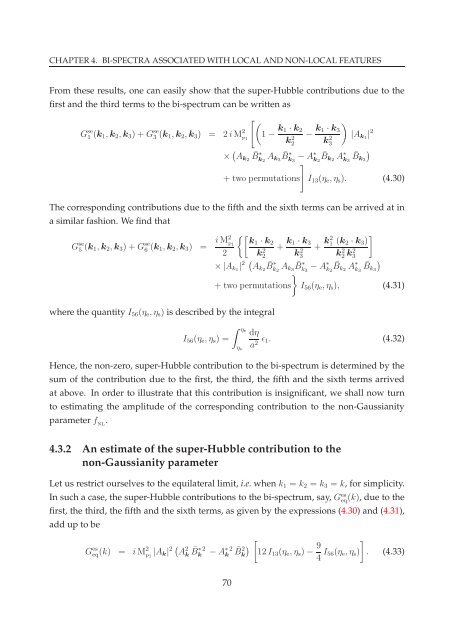PHYS08200605006 D.K. Hazra - Homi Bhabha National Institute
PHYS08200605006 D.K. Hazra - Homi Bhabha National Institute
PHYS08200605006 D.K. Hazra - Homi Bhabha National Institute
Create successful ePaper yourself
Turn your PDF publications into a flip-book with our unique Google optimized e-Paper software.
CHAPTER 4. BI-SPECTRA ASSOCIATED WITH LOCAL AND NON-LOCAL FEATURES<br />
From these results, one can easily show that the super-Hubble contributions due to the<br />
first and the third terms to the bi-spectrum can be written as<br />
[ (<br />
G se<br />
1 (k 1 ,k 2 ,k 3 )+G se<br />
3 (k 1 ,k 2 ,k 3 ) = 2iM 2 1− k 1 ·k 2<br />
− k )<br />
1 ·k 3<br />
|A<br />
Pl<br />
k2<br />
2 k3<br />
2 k1 | 2<br />
× ( )<br />
A k2<br />
¯B∗ k2<br />
A k3<br />
¯B∗ k3<br />
−A ∗ ¯Bk2 k 2<br />
A ∗ ¯Bk3 k<br />
] 3<br />
+ two permutations<br />
I 13 (η e ,η s ). (4.30)<br />
The corresponding contributions due to the fifth and the sixth terms can be arrived at in<br />
a similar fashion. We find that<br />
{[<br />
G se<br />
5 (k 1,k 2 ,k 3 )+G se<br />
6 (k 1,k 2 ,k 3 ) = iM2 Pl k1 ·k 2<br />
+ k ]<br />
1 ·k 3<br />
+ k2 1 (k 2 ·k 3 )<br />
2 k2<br />
2 k3<br />
2 k2 2k2 3<br />
×|A k1 | ( )<br />
2 A k2<br />
¯B∗ k2<br />
A k3<br />
¯B∗ k3<br />
−A ∗ k<br />
¯Bk2 2<br />
A ∗ k<br />
¯Bk3<br />
}<br />
3<br />
+two permutations I 56 (η e ,η s ), (4.31)<br />
where the quantity I 56 (η e ,η s ) is described by the integral<br />
I 56 (η e ,η s ) =<br />
∫ ηe<br />
η s<br />
dη<br />
a 2 ǫ 1. (4.32)<br />
Hence, the non-zero, super-Hubble contribution to the bi-spectrum is determined by the<br />
sum of the contribution due to the first, the third, the fifth and the sixth terms arrived<br />
at above. In order to illustrate that this contribution is insignificant, we shall now turn<br />
to estimating the amplitude of the corresponding contribution to the non-Gaussianity<br />
parameterf NL<br />
.<br />
4.3.2 An estimate of the super-Hubble contribution to the<br />
non-Gaussianity parameter<br />
Let us restrict ourselves to the equilateral limit, i.e. when k 1 = k 2 = k 3 = k, for simplicity.<br />
In such a case, the super-Hubble contributions to the bi-spectrum, say, G es<br />
eq(k), due to the<br />
first, the third, the fifth and the sixth terms, as given by the expressions (4.30) and (4.31),<br />
add up to be<br />
G es<br />
eq(k) = iM 2 |A Pl<br />
k| 2( A 2 ¯B<br />
) [<br />
k k ∗2 −A ∗ k 2 ¯B2 k 12I 13 (η e ,η s )− 9 ]<br />
4 I 56(η e ,η s ) . (4.33)<br />
70
















